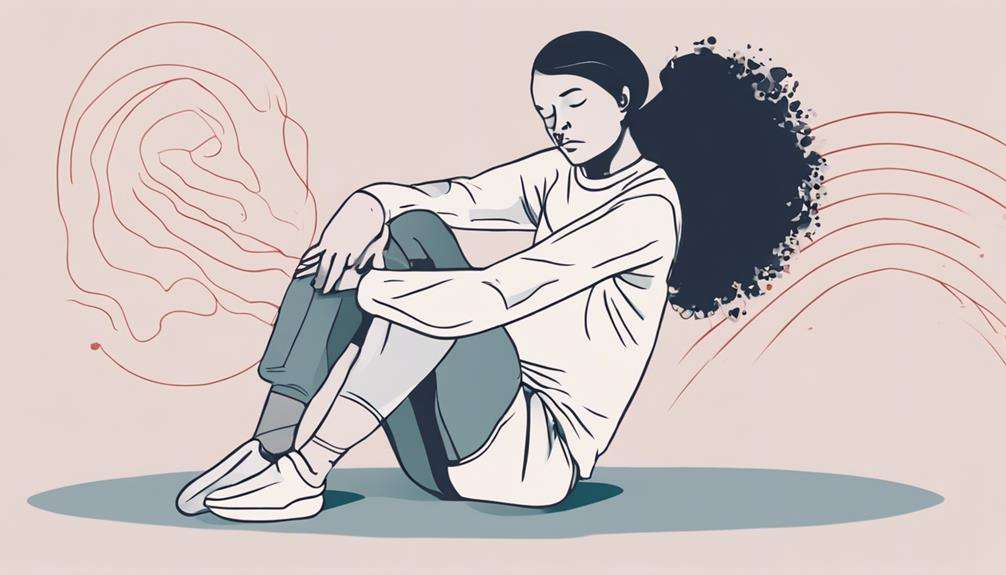When it comes to managing hypertension, breathing techniques can play a significant role in helping you maintain ideal blood pressure levels. These techniques offer a gentle yet powerful way to support your cardiovascular health by addressing the underlying factors contributing to high blood pressure.
By incorporating simple breathing exercises into your daily routine, you can experience notable improvements in your blood pressure readings and overall well-being. But how exactly do these techniques work their magic?
Let's explore the fascinating connection between breathing and hypertension further.
Key Takeaways
- Deep breathing techniques lower systolic blood pressure significantly.
- Yoga breathing activates the parasympathetic system, reducing hypertension.
- Regular practice improves heart rate variability and reduces stress levels.
- Device-guided exercises like RESPeRATE aid in effective blood pressure control.
The Role of Breathing in Hypertension
Breathing plays an important role in the management of hypertension. Deep breathing techniques show significant effectiveness in lowering systolic blood pressure. Slow breathing is also beneficial, reducing sympathetic tone and increasing parasympathetic tone, which helps individuals with hypertension.
Heart rate variability, an indicator of autonomic nervous system function, improves with breathing exercises, showcasing their positive impact on blood pressure regulation.
Slow-loaded breathing, pursed lip breathing, and alternate nostril breathing have been proven to effectively lower blood pressure levels in hypertensive patients. Studies suggest that incorporating these techniques into a daily routine for 10-60 minutes can lead to notable improvements in blood pressure control.
Understanding Hypertension and Breathing Techniques
Understanding hypertension and breathing techniques is pivotal for managing high blood pressure effectively.
You'll explore the basics of hypertension, discover the benefits breathing techniques offer, and learn about specific methods to control your blood pressure levels.
Hypertension Basics Explained
Hypertension, also known as high blood pressure, is a prevalent condition affecting approximately half of U.S. adults and is a significant risk factor for heart disease and stroke.
Breathing techniques such as diaphragmatic breathing and device-guided exercises play an important role in managing high blood pressure. Studies show that techniques like Sama vritti and 4-7-8 breathing can effectively lower blood pressure.
For instance, a recent review highlighted that just 2 minutes of deep breathing can reduce systolic blood pressure by 8.6 mm Hg and diastolic blood pressure by 4.9 mm Hg. Utilizing tools like RESPeRATE can also aid in lowering blood pressure levels.
Consistent practice of these techniques can enhance lung efficiency and bring about significant reductions in blood pressure for hypertensive individuals.
Benefits of Breathing
Enhancing your understanding of the benefits associated with proper breathing techniques can greatly impact the management of hypertension.
Breathing techniques play a critical role in reducing blood pressure, specifically systolic blood pressure, by up to 10 points, which can be particularly beneficial for individuals with stage 1 hypertension.
Consistent practice of breathing exercises for just a few minutes daily has shown significant reductions in blood pressure levels.
Deep breathing not only helps lower sympathetic tone but also increases parasympathetic tone and enhances baroreflex sensitivity in hypertensive patients.
Studies have demonstrated that slow breathing techniques effectively decrease both systolic and diastolic blood pressure in individuals dealing with hypertension.
Techniques for Control
Utilizing specific breathing techniques can be a powerful tool in effectively managing and controlling blood pressure levels for individuals with hypertension. Deep breathing exercises, such as diaphragmatic breathing and 4-7-8 breathing, have shown significant reductions in both systolic and diastolic blood pressure readings. Regular practice of these techniques can lead to a decrease of up to 10 points in blood pressure, comparable to the effects of some medications.
Simple yet effective controlled breathing methods like Sama Vritti and the 30-Second Breathing Exercise offer accessible ways to manage hypertension. Additionally, device-guided breathing exercises, like those facilitated by RESPeRATE, have been proven to be effective in lowering blood pressure when consistently utilized.
Research underscores the safety and efficacy of breathing exercises in hypertension management, emphasizing their role in promoting better blood pressure control.
Benefits of Yoga Breathing for Blood Pressure
Yoga breathing techniques, such as pranayama, offer a valuable approach for managing blood pressure through their ability to activate the parasympathetic nervous system and induce relaxation. By engaging in controlled breathing practices like Anulom Vilom and Bhramari, individuals with hypertension can experience a reduction in blood pressure levels.
These techniques work by calming the mind and body, promoting a state of relaxation that's beneficial for cardiovascular health. Research has shown that regular practice of yoga breathing not only helps in reducing blood pressure but also improves heart rate variability, which is important for overall well-being.
Additionally, incorporating yoga breathing into a complete hypertension management plan can lead to significant improvements in stress levels, further supporting the notion that these techniques play a crucial role in enhancing both physical and mental health for individuals struggling with hypertension.
How Breathing Affects Hypertension

Breathing plays an important role in influencing hypertension by affecting various physiological parameters such as blood pressure levels and autonomic nervous system activity.
Deep breathing techniques have been shown to lower systolic blood pressure by up to 10 points, offering significant benefits for individuals with hypertension.
Slow breathing positively influences autonomic nervous system parameters like muscle sympathetic nerve activity and heart rate variability, contributing to reduced blood pressure.
Controlled breathing helps increase parasympathetic tone, lower sympathetic tone, and enhance baroreflex sensitivity, all of which aid in managing hypertension.
Various breathing exercises, including slow-loaded breathing and device-guided slow breathing, have demonstrated reductions in both systolic and diastolic blood pressure levels.
Daily practice of breathing exercises for 10-60 minutes has proven effective in improving blood pressure regulation and overall cardiovascular health in hypertensive patients.
Incorporating these breathing techniques into your daily routine can have a significant impact on managing hypertension and promoting cardiovascular well-being.
Exploring Yoga Techniques for Hypertension
Yoga offers various poses and breathing exercises that can be beneficial for managing hypertension. By incorporating these techniques into your routine, you may experience improvements in stress levels and blood pressure control.
The mindfulness aspect of yoga can further complement these benefits, contributing to overall cardiovascular health in individuals with hypertension.
Yoga Poses for Hypertension
Exploring various yoga poses can be beneficial for individuals with hypertension, offering a natural approach to stress reduction and blood pressure management. Yoga poses like Savasana, Sukhasana, and Balasana are known to lower blood pressure and reduce stress levels in individuals with hypertension. These poses, combined with controlled breathing techniques such as Anulom Vilom and Bhramari pranayama, can effectively improve heart health and overall cardiovascular well-being.
Regular practice of yoga has been shown to enhance relaxation, promote overall well-being, and reduce hypertension risk factors. Integrating yoga into daily routines can complement traditional treatments for hypertension, leading to improved cardiovascular health outcomes. Make yoga a part of your routine to support blood pressure management and enhance your overall health.
Breathing Exercises Benefits
When it comes to managing hypertension through natural methods, incorporating specific techniques like Sama Vritti and diaphragmatic breathing can greatly impact blood pressure levels in individuals.
Yoga breathing exercises offer significant benefits for hypertension by lowering blood pressure and improving heart rate variability. Practices such as alternate nostril breathing and slow-loaded breathing have shown positive effects on reducing systolic and diastolic blood pressure readings.
Regular engagement in these techniques, for 10-60 minutes daily, can enhance cardiovascular health and promote overall well-being.
Additionally, incorporating methods like pursed lip breathing and IMST into your routine can complement traditional hypertension management strategies effectively. By integrating these breathing exercises into your daily regimen, you can actively contribute to managing high blood pressure and supporting your cardiovascular health.
Mindfulness in Yoga
Incorporating mindfulness techniques in managing hypertension involves embracing the meditative aspects of yoga practice to cultivate a state of awareness that can positively impact stress levels and blood pressure regulation.
Yoga, with its focus on mindfulness practices like Savasana and Sukhasana, promotes relaxation and aids in lowering blood pressure. Additionally, yoga breathing techniques such as Pranayama emphasize controlled breathing to calm the mind and body, contributing to stress reduction.
Regular yoga practice has shown significant improvements in heart health, circulation, and overall well-being for individuals with hypertension. Mindful movement through yoga, such as Vinyasa flow sequences, enhances flexibility, reduces tension, and supports blood pressure regulation.
Embracing these yoga techniques can be a valuable addition to hypertension management strategies.
Impact of Breathing Exercises on Blood Pressure
Breathing exercises have demonstrated a significant ability to lower blood pressure effectively, as evidenced by a 2023 review showing that just 2 minutes of deep breathing can reduce systolic blood pressure by 8.6 mm Hg and diastolic blood pressure by 4.9 mm Hg. Techniques like diaphragmatic breathing, Sama vritti, and the 4-7-8 breathing exercise have been shown to improve blood pressure.
Deep breathing practices, when incorporated into daily routines, have the potential to reduce blood pressure levels. Methods such as device-guided breathing, including RESPeRATE, have also proven effective in lowering blood pressure when used consistently. Regular practice of slow deep breathing over a 12-week period has been linked to significant reductions in blood pressure among individuals with hypertension.
Embracing breathing exercises as part of your daily routine can't only enhance lung efficiency but also effectively lower blood pressure, providing a natural and safe way to manage hypertension.
Yoga Breathing Methods for Lowering Hypertension

Yoga breathing methods, particularly Pranayama, have been scientifically proven to effectively lower blood pressure in individuals with hypertension. These techniques work by activating the parasympathetic nervous system, inducing a state of relaxation that can help reduce stress levels. Studies indicate that regular practice of yoga breathing exercises like Anulom Vilom and Bhramari can lead to improved heart rate variability, ultimately lowering the risk of hypertension.
By engaging in controlled breathing patterns, individuals can enhance oxygen delivery, improve circulation, and support overall cardiovascular health. Deep breathing in yoga not only promotes relaxation but also aids in managing hypertension effectively. Incorporating these yoga breathing methods into a daily routine can be a valuable tool in lowering blood pressure and fostering overall well-being.
Practice of these techniques may offer individuals a natural and accessible way to support their cardiovascular health and manage hypertension.
Incorporating Breathing Practices for Hypertension
Implementing specific breathing practices has been shown to significantly reduce systolic and diastolic blood pressure readings in individuals with hypertension. Techniques such as diaphragmatic breathing and 4-7-8 breathing have demonstrated effectiveness in managing blood pressure levels.
Research indicates that engaging in deep breathing exercises can lead to a significant decrease in blood pressure, with reductions of up to 8.6 mm Hg in systolic pressure and 4.9 mm Hg in diastolic pressure observed within just 2 minutes.
Methods like Sama Vritti and device-guided breathing tools such as RESPeRATE can also play a crucial role in blood pressure management for individuals with hypertension. These breathing practices aren't only essential but also beneficial for enhancing cardiovascular health and improving overall lung efficiency.
Frequently Asked Questions
How Does Breathing Affect Your Blood Pressure?
When you breathe deeply, your blood pressure can lower. Stress reduces, oxygen intake increases, and your body triggers a relaxation response. Heart rate slows, blood flow improves, and the mind-body connection strengthens, benefiting overall health.
How Does the Respiratory System Help With Blood Pressure?
Your respiratory system supports blood pressure regulation through lung function and oxygen exchange. Diaphragmatic breathing triggers a relaxation response, benefiting cardiovascular health. These mechanisms aid in hypertension management by improving overall cardiovascular function.
How Do You Control High Blood Pressure by Breathing?
Take deep breaths to control high blood pressure. Relaxation response from breathing exercises strengthens mind-body connection, reduces stress. Embrace controlled breathing techniques for better health. Your breath can be a powerful tool for wellness.
What Is the Role of Paced Breathing for Treatment of Hypertension?
Paced breathing plays an important role in hypertension treatment by promoting relaxation, mindfulness, and stress reduction. The benefits include improved blood flow, reduced sympathetic activity, and enhanced baroreflex sensitivity. Practicing controlled breathing regularly contributes to long-term health benefits.
Conclusion
To sum up, breathing techniques play a vital role in managing hypertension by effectively lowering blood pressure levels.
Research has shown that regular practice of techniques like the 4-7-8 breathing exercise can lead to significant reductions in systolic and diastolic blood pressure.
In fact, studies have found that just a few minutes of daily breathing exercises can result in a notable decrease in blood pressure readings, making them a valuable tool in hypertension management.






